Abstract
A polygeneration system for power, heat, and refrigeration has been evaluated and optimized using exergy-based methods. CO2 is the working fluid. The study considered two environmental conditions for the potential implementation of the polygeneration system: cold (Casecold) and hot (Casehot). Aspen HYSYS® was used to perform steady-state simulations, Python was used for the automation of the process, and the connection of Aspen HYSYS® with Python was successfully applied for single-objective and multi-objective optimizations. A wide range of decision variables was implemented. The minimization of the average cost of a product per unit of exergy was the goal of single-objective optimization and was included in the multi-objective optimization in addition to the maximization of the overall exergy efficiency. Single-objective and multi-objective optimization were applied. Both optimization algorithms result in the necessity to increase the pinch temperature in the heat exchanger (ΔTpinch,HE), maintain the pinch temperature in the gas cooler (ΔTpinch,GC), and augment this value for the evaporator (ΔTpinch,EVAP). Notably, higher isentropic efficiency for turbomachinery correlates with improved optimization outcomes. These findings contribute to the applicability and performance of the polygeneration system, offering potential advancements in sustainable energy solutions.
1. Introduction
The World Energy Outlook 2023 [1] (International Energy Agency, IEA) reports an average annual growth rate of 0.7% in total energy demand (Stated Policies Scenario) and flattening total energy demand (Pledges Scenario) because of improvements in the energy efficiency of existing technologies and advantages in technologies powered by electricity (mainly, electricity from renewable energy sources [2]) over fossil-fuel-based alternatives. In the net-zero emissions scenario, the primary energy demand has a negative growth rate of 1.2% per year until 2030.
Regarding CO2 emissions, the technologies still unavailable on the market, i.e., those at the prototype or demonstration phase, delivered nearly 50% of the emissions reductions (net zero emissions scenario in 2050). The actual status is around 35%. Particular attention should be given to the off-grid solutions [1].
The configuration and the application of polygeneration systems depends on the scale [2,3]:
- Large-scale industrial systems find a wide application in complex manufacturing processes such as petrochemicals, textiles, and food processing, where three energetic effects (electricity, heat (in the form of steam), and cooling) are required simultaneously. The production of chemical substances is also possible. Polygeneration is a sustainable solution for urban areas as district energy systems. These systems can be designed as a synergy between the energy and non-energy sectors by centralizing energy production and distribution.
- Middle-scale systems are well-known for their application in hospitals, university campuses, and small manufacturing plants. The number of residential, business, and commercial buildings that use air conditioning intensively has increased dramatically in recent years. A large amount of cold is required for servers (equipment for IT-related technologies, etc.). This is a global problem that needs attention.
- Small-scale systems often belong to off-grid solutions [4]. Such systems have high design flexibility and the highest potential for integration of renewable sources (solar and wind) up to 100%. This approach addresses the challenges of renewable energy variability by providing a consistent energy supply through complementary sources. Small-scale off-grid systems contribute positively to the net zero emissions scenario. A considerable boost in system efficiency has been observed in polygeneration systems.
The modern term “polygeneration” can be treated as a synonym for “cogeneration“, “tri-generation”, and “multigeneration”. Not only can energetic effects be included in the generated products list, but freshwater due to water desalination, hydrogen from water electrolysis, syngas from biomass gasification, etc., can also be included in the generated products (for example, [5,6]).
There are a large number of research papers dedicated to polygeneration systems. The Scopus database (November 2023) was used to identify these publications and cluster the keywords. Such an approach can help readers obtain an overview of the already-published results and highlight the directions for research. Thousands of publications were identified using the keyword “polygeneration”; later, they were filtered using the field of research “energy” with attention to “carbon dioxide” (as emissions and as the working fluid). Only publications in English were considered. Finally, a list of around 500 research publications was generated. The dynamics of the publications are shown in Figure 1a. Only papers published during the last 10 years were further used to cluster the keywords (Figure 1b).
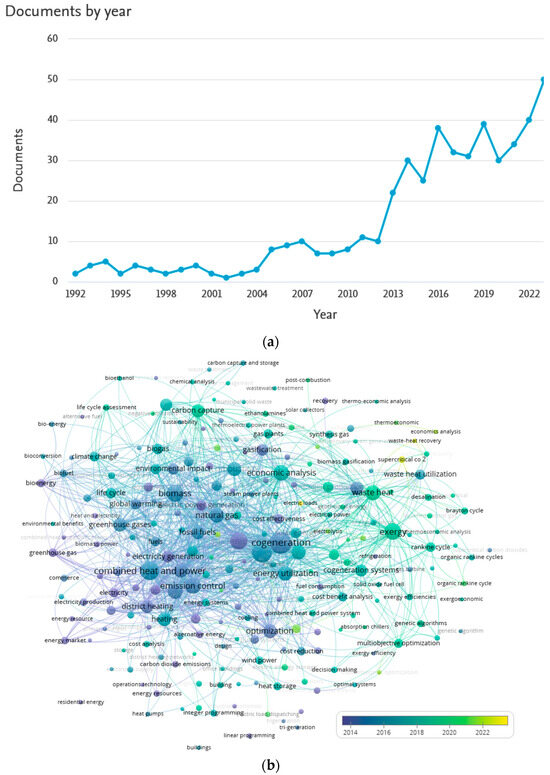
Figure 1.
Bibliometric study: (a) dynamics of publications (Scopus); (b) clustering the keywords (VOSViewer software, 1.6.16).
From Figure 1b, we can see that a large cluster corresponds to the publications addressing the combination of heat and power generation. The topic of waste heat utilization is also well-identified, with several large clusters. However, tri-generation systems (bottom of Figure 1a) and “cooling” (“refrigeration”) present relatively small clusters with weak connections to others. The research methods include theoretical research (and optimization), laboratory experiments, and pilot plants. The papers related to the optimization and application of exergy-based methods (thermoeconomics = exergoeconomics) form clusters in green and yellow colors; they were published during the last 3 to 4 years.
Solar-powered, as well as solar-biomass-powered or solar-geothermal-powered, polygeneration systems have been the subject of extensive study, analysis, and optimization because of their potential to contribute positively to the goals of sustainability, namely, energy efficiency, economic feasibility, and reducing emissions. For example, a comprehensive review of perspectives on solar-driven polygeneration systems of different scales is reported in [7]. The so-called 4E analysis has been applied to evaluate and optimize a medium-scale system based on the combination of solar and geothermal resources [8]. The multicriteria analysis and optimization of the medium-scale polygeneration hybrid solar-biomass system are reported in [9]. A novel stochastic planning model for renewable distributed generation (DG) in distribution networks was proposed, considering investment in conventional assets and smart grid assets like demand-side response and coordinated voltage control. The authors also considered active power generation curtailment. The model used a node-variable formulation to alleviate computational burden. The study demonstrated smart technologies’ strategic value due to flexibility in system evolution [10].
Waste heat utilization represents a large cluster in the research on polygeneration. A review of existing technologies and their perspectives is reported in [11]. Such systems can cover all scales, from very large (for example, [12,13], where the natural-gas-based polygeneration systems are evaluated) to medium- and small-sale. For the generation of the refrigeration and/or heat capacity, ejector systems [14] or their combinations [6] can be used.
Vapor-compression refrigeration systems dominate in stand-alone applications driven by electricity (including small-scale systems driven by locally generated electricity from renewables). However, compression refrigeration machines can also be driven directly by internal combustion engines or small- or medium-scale power systems based on the organic Rankine cycle. A combination has a classification name: “thermally-driven compression refrigeration systems”.
This paper addresses a small- and medium-scale polygeneration system with CO2 as the working fluid. A conceptual design is shown in Figure 2. The authors already discussed and evaluated the application of such a system in [15,16].
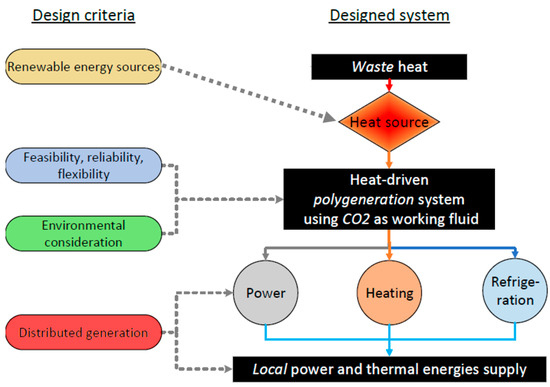
Figure 2.
A conceptual design of an off-grid polygeneration system.
During the last decade, CO2 as a working fluid for refrigeration, heat pump systems, or power generation has been extensively studied. For example, the authors contributed to this research in [17,18,19].
A CO2 cogeneration system, as the combination of the vapor-compression refrigeration system and the recompression Brayton cycle, was evaluated in [20] using energy, exergy, and economic analyses. The parametric sensitivity analysis was conducted to discover a set of decision variables. One-criteria optimization (maximum energy efficiency, maximum exergy efficiency, or minimum total product cost) has been conducted. For cogeneration, the optimal (minimal) cost of the products is 3.5% lower than the cost obtained for optimal (maximum) energy and efficiency. Under the assumption that refrigeration capacity is the sole effect, the optimal (minimum) total product cost can be decreased by 19% compared to a base case, 4% lower than the cost obtained for optimal (maximum) energy and efficiency.
In [21], the system for utilizing the heat from exhaust gases from the shipboard gas-turbine system is evaluated. A cogeneration system consists of the supercritical and transcritical CO2 cycles. The coefficient of performance (COP) of 2.75 was calculated for the base case and can be improved by more than 10% because of improvements in the Brayton (supercritical) cycle.
A supercritical CO2 cycle with preheating was proposed for the waste heat recovery from an engine [22]. The maximum net power output can be increased by around 7%. The results demonstrate that improving the preheating process within the S-CO2 cycle can achieve deeper utilization of the waste heat, leading to an increase in the entire system performance by another 7%.
A novel two-stage transcritical CO2 refrigeration cycle was proposed in [23]. Two ejectors are implemented in the vapor-compression cycle. The reported results show that the improvement potential is between 20% and 80% (value of COP) and heavily depends on the operation conditions. The experimental results of the transcritical CO2 systems are reported in [24,25]. The first paper reports on an ejector refrigeration system, with particular attention to the design of the ejector. The second paper reviews experimental investigations of the heat-to-upgraded-heat and heat-to-power systems (terminology used in [25]). Particular attention is given to the heat transfer characteristics and the design of the compressors and expanders.
A multi-objective optimization for a large-scale integrated energy system based on energy hubs was conducted in [26]. The method considers economic analysis, energy consumption, and environmental benefits and employs the ε-constraint-fruit fly optimization algorithm. Results show that the proposed method reduces annual total cost, primary energy consumption, and CO2 emissions by approximately 2%, 5%, and 7%, respectively.
The bilayer model which utilizes historical data and conservativeness to mitigate uncertainties for multi-energy building microgrids was presented in [27]. It determines the energy storage dispatch, demand–response, and on–off hourly operation of a power generation system. Numerical case studies show the effectiveness of the evaluation approach in achieving economically effective operations with high computational performance and immunity against uncertainties.
The potential of heat-driven vapor-compression refrigeration systems is still not fully understood. This study makes a substantial contribution to the continuing investigation of heat-driven vapor-compression refrigeration systems, with a particular focus on the off-grid operation. A gap in knowledge and application is addressed by describing the optimization processes and associated algorithms. It explores the complexities of simulation and automation processes. In addition, the study stands out because it explores various optimization goals by conducting single-objective and multi-objective optimization.
This paper aims to do the following:
- To describe the simulation and automation processes as the prerequisites for optimization;
- To evaluate comprehensively the polygeneration system with CO2 as the working fluid to identify the decision variables;
- To describe the optimization procedures and associated algorithms;
- To conduct single and multi-objective optimization;
- To conduct a comparative study between evaluated and reported solar-driven and waste heat-driven polygeneration systems.
2. System Description
Figure 3a shows the basic design of the polygeneration system being evaluated, and Figure 3b illustrates its thermodynamic cycle. The polygeneration system consists of nine components within two sub-cycles:
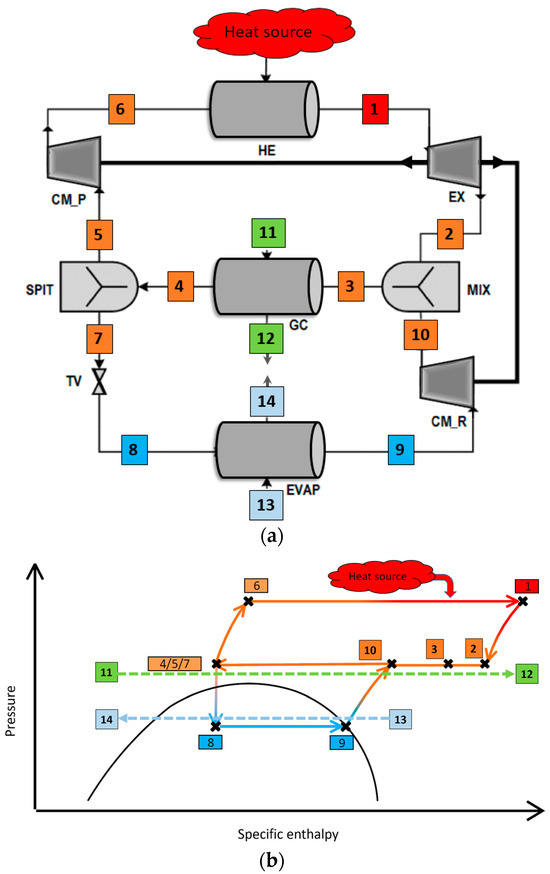
Figure 3.
CO2 polygeneration system: (a) schematic; (b) thermodynamic cycle.
- A power sub-cycle is composed of a compressor for the power cycle (CM–P), a heat exchanger (HE), and an expander (EX). The “driving energy” (for example, solar energy, heat from biomass combustion, waste heat, etc.) for the entire system is supplied to the HE.
- A refrigeration sub-cycle includes a throttling valve (TV), an evaporator (EVAP), and a compressor for the refrigeration cycle (CM–R). The refrigeration capacity is generated within the EVAP.
A gas cooler (GC), a mixer (MIX), and a splitter (SPLIT) link these sub-cycles. Carbon dioxide is the working fluid for the entire system. The heat capacity is generated within the gas cooler. The system can generate net power as the difference between the power from EX and the power required by both compressors (CM–P and CM–R).
3. System Simulation and Automation
Aspen HYSYS® (ver. 10, AspenTech, Bedford, MA, USA) has been used as a simulation tool. To apply mass and energy balances, the Span–Wagner equations of state were selected. These equations are more accurate in predicting CO2 thermodynamic properties in a wide range of temperatures and pressures, including the vicinity of the critical point.
The simulation results obtained from Aspen HYSYS® were exported for computing the analysis of system and component levels, evaluation, and optimization. With the aid of programming software, the parameters and values being exported from the simulation software and imported into the simulation software can be automated. Python was connected to Aspen HYSYS® to automate the entire calculation process. The communication was managed through a binary interface component object model. Automation is advantageous, particularly for optimization.
The initially developed design needs to be evaluated. For this purpose, energetic and exergy-based analyses were conducted using a large set of simulations. The economic analysis has been conducted separately. The authors report this process in detail in [15]. Thermodynamic performance, cost of the system product(s), environmental aspects, safety, and reliability were considered. The obtained results are used for this research.
4. System Evaluation
In this study, evaluation and optimization are conducted at the system level. A component-level evaluation was already reported by the authors in [15,16]. Only physical exergy is considered for the exergy analysis. Chemical, kinetic, and potential exergy are neglected. The approach “exergy of fuel/exergy of the product” is applied to conduct the exergy and exergoeconomic analysis.
The exergy balance for the overall system is written as
and the overall exergy efficiency is
where for the system being evaluated (Figure 3), the exergy of fuel is ; the exergy of product is with ; and and . Here, is the average temperature of the heat source supplied to the system in the HE.
The cost balance for the overall system is
For calculating the capital investment rate the total revenue requirement method (the application can be found in many papers, for example, in [17]) of the economic analysis was applied with the following assumptions: (a) the plant’s economic lifetime is 20 years; (b) the effective interest rate is 10%; and (c) the average general inflation rate is 2.5%.
For estimating the purchased equipment cost (PEC) for each component, the following was considered (detailed explanations are reported by authors in detail [15]):
- Heater (HE) and gas cooler (GC) are compact printed circuit heat exchangers made of stainless steel. Therefore, the cost of such a heat exchanger is estimated by its weight [28]:
- Evaporator (EVAP) [30]:where = 32,800 USD; = 80 m2; M = 0.68, and 1.3.
- Turbomachinery of the power sub-cycle (CM-P and EX) [29]:
- Turbomachinery of the refrigeration sub-cycle (CM_R) [30]:where = 32,800 USD; = 80 m2; M = 0.68, and 1.3.
- The cost of the throttling valve (TV) equals 100 EUR [17], and the costs of the mixer and the splitter are neglected.
5. System Optimization
Parameter optimization and structure optimization are two methods for improving the performance of the overall system. Product (single or cumulative for a multigeneration system) cost minimization is one of the most commonly applied objective functions for commercial systems, while energy (exergy) efficiency maximization is associated with thermodynamic optimizations, i.e., minimization of the primary energy for the energy-conversion system (and associated emissions). A set of decision variables and their constraints were discussed by the authors in [15]. In this study, two types of parameter optimization have been applied: single-objective and multi-objective.
To solve the design optimization problems, stochastic algorithms—individual-based and population-based—are selected. The population-based algorithms widely applied in engineering are evolutionary, physical, and swarm-based algorithms. Genetic algorithms are the earliest and most well-known evolutionary algorithms.
Two relatively new algorithms (Figure 4) were selected and applied to solve the single-optimization problem:
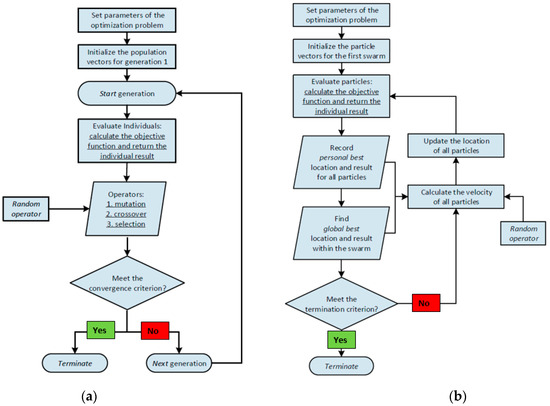
Figure 4.
Implementation of optimization algorithms: (a) differential evolution-DE; (b) particle swarm optimization–PSO.
- The differential evolution (DE) algorithm was introduced in 1997 [31]. The DE algorithm is similar to the genetic algorithm but modified for more straightforward implementation, less computation time, reliability, and robustness.
- The particle swarm optimization (PSO) algorithm was first suggested in 1995 [32]. The potential candidates in this algorithm are called particles. A group of particles work together to continuously improve their individual and collective performance on a given optimization task [33]. In addition, less computational effort is required for solving moderate-dimensional problems. It is also robust and straightforward. PSO is an excellent option for solving high-dimensional optimization problems.
For multi-objective optimization problems, the non-dominated sorting genetic algorithm-II (NSGA-II) is chosen [31] as one of the most popular and successful optimization tools. The NSGA-II can produce a Pareto frontier, or non-dominated set of solutions, which shows the trade-off between the two objective functions without any solution being superior to the others.
Optimization problems consist of three essential components:
- Objective functions
- ○
- Single-objective parametric optimization:This involves the global optimization of decision parameters.
- ○
- Multi-objective parametric optimization:
- Set of decision variables:where ∆Tpinch represents the temperature differential (pinch point) in a heat exchanger; and η represents the isentropic efficiency of turbomachinery.
- Constraints of decision variables:
Two operation conditions were considered to represent the performance of the proposed polygeneration system in hot and cold climates, as follows:
- Casehot for the hot climate operation with an average environmental temperature of 35 °C;
- Casecold for the cold climate operation with an average environmental temperature of 5 °C.
A medium-temperature heat source suitable for the evaluated polygeneration systems is in the range of 320–590 °C [15].
6. Results and Discussion
6.1. Single-Objective Parametric Optimization
The results of the single-objective optimization are shown in Table 1 (Casehot) and Table 2 (Casecold). The comparison of the values obtained using both DE and PSO algorithms is given as well.

Table 1.
A single-objective parametric optimization utilizing DE and PSO algorithms for the polygeneration system at Casehot operation conditions.

Table 2.
A single-objective parametric optimization utilizing DE and PSO algorithms for the polygeneration system at Casecold operation conditions.
After the optimization for Casehot, the average cost of a product decreased by 25% from its original value, and the optimum solutions between DE and PSO are within the limit of 1.0%. The differences between DE and PSO optimum solutions are in the range of 2.5% for isentropic efficiency of turbomachinery and pMerging. The optimal minimum temperature in all heat exchangers, ∆Tpinch, has relatively large (in the limit of 25%) differences between the initial and optimal values obtained by the DE and PSO algorithms. However, relative values should not be the only ones to be considered. The change in the absolute values of ΔTpinch by 1 K shows that the obtained results are within the limits of technical possibility for improving a heat exchanger while keeping the same design.
The optimization results for Casecold show a decrease in the average cost of a product by 15% from its original value, and optimum solutions between DE and PSO are at the limit of 1.0%.
When comparing the optimization results using DE and PSO algorithms, the largest relative difference of 60% is observed in the pinch point temperature difference for the EVAP. Starting with the initial value of ∆Tpinch,EVAP = 5 K, the DE algorithm suggests increasing to 10 K, while the PSO algorithm suggests decreasing down to 4 K. Similar dynamics have also been suggested for the value of ∆Tpinch,GC: a smaller value (6 K) suggested by the PSO algorithm compared to 7 K by the DE algorithm. All values obtained by optimization are within the limits of technical possibility for heat exchangers and turbomachinery.
The execution time for Casehot varied between 1820 s (DE) and 1633 s (PSO); while for Casecold, it varied between 1944 s (DE) and 1699 s (PSO). The PSO algorithm completes the optimization process roughly 200 s faster.
For example, the best values of decision variables obtained from both optimization algorithms for Casecold are shown in Figure 5. The PSO algorithm already had a better starting position in the first iteration and continued to lower the objective function until the fifth iteration. A local minimum was identified within the sixth to ninth iterations, which had further minor corrections until the tenth iteration. No better value is obtained after the 10th iteration. Another dynamic is observed for the application of the DE algorithm. Significant progress was achieved in the second iteration; a local minimum was identified within the eighth to eighth iterations, with minor corrections within the fourteenth to fifteenth iterations.
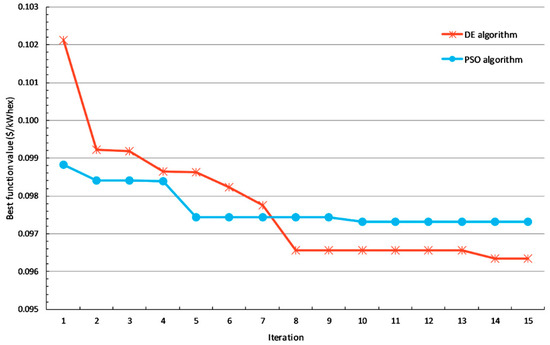
Figure 5.
The optimization process using the DE and PSO algorithms (Casecold).
6.2. Multi-Objective Parametric Optimization
Figure 6 shows the Pareto frontier for the entire polygeneration system at warm and cold operation conditions. As expected, an absolute optimal solution does not exist, indicating that the higher the system exergy efficiency, the lower the product cost. For the Casehot, an extensive flat profile is observed, which indicates a “slow” growth in the average product cost while improving the system efficiency. Such a flat area in the Casecols is minimal.
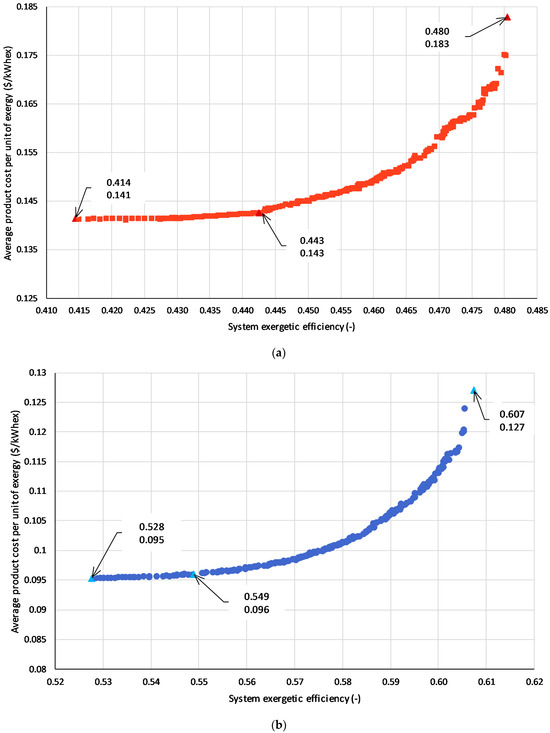
Figure 6.
The Pareto frontiers for the polygeneration system: (a) Casehot,; (b) Casecold.
In the limit of decision variables, for Casehot operation conditions, maximum and minimum overall exergy efficiencies are 0.480 and 0.414, respectively, with the trade-off of the average cost of the product per unit of exergy 0.183 USD/kWhex and 0.141 USD/kWhex. A relative difference between the limiting values is an increase in the exergy efficiency of 16%, which corresponds to a decrease in the average product cost of 23%. The optimum values are 0.443 and = 0.143 USD/kWhex.
For Casecold operation conditions, 0.549 and = 0.096 USD/kWhex. Maximum and minimum overall exergy efficiencies are 0.607 and 0.528, i.e., a relative difference of 15%. In contrast, the minimum and maximum values of the average cost of the product per unit of exergy are 0.095 USD/kWhex and 0.127 USD/kWhex, respectively, which is 25%.
6.3. Comparative Analysis with Solar-Driven Polygeneration Systems
A set of six papers [25,33,34,35,36,37] was selected to compare the results obtained by the authors. In these papers, the exergy study, economic evaluation, and exergoeconomic variables were used for the optimization. Table 3 presents the comparative insights, which include net power production (), overall exergy efficiency (εtot), and the mean total cost of the product ( USD/GJex). The compared systems are classified as middle-scale off-grid polygeneration systems, with capacities between 50 and 370 kW, which is what this comparative analysis is all about. The differences in the reported values are caused by evaluated system configurations, selected working fluids, particular operating conditions, and the evaluation and optimization routines in each study. Nevertheless, the authors’ results fit the entire map of the results and contribute to the state-of-the-art.

Table 3.
Key system variables of the reported solar-driven polygeneration systems and current work.
7. Conclusions
The emphasis of this research was placed on the evaluation and optimization of the off-grid polygeneration system with CO2 as the working fluid. Exergy-based methods were applied on the system level. The simulation of the system was conducted using Aspen HYSYS®, and to ensure a comprehensive assessment and optimization process, an automated procedure was established to connect Aspen HYSYS® with Python.
The goal of the single-objective optimization was to minimize the average cost per unit of exergy of a product. This objective transitioned into multi-objective optimization, where the emphasis extended beyond cost considerations to maximization of overall exergy efficiency.
This comprehensive approach contributes to the scientific understanding of polygeneration systems and lays the groundwork for informed decision-making in the pursuit of sustainable and efficient energy solutions.
The main obtained results can be summarized as follows:
- The polygeneration system demonstrates sustainability benefits by simultaneously producing multiple energy effects, i.e., power, heat, and refrigeration capacities.
- The polygeneration system exhibits adaptability for a wide range of thermally driven applications, from solar-thermal to waste heat utilization.
- Parametric optimization methods, encompassing single- and multi-objective optimization, were applied to optimize the polygeneration system. Two operation conditions, Casehot and Casecold, were selected for thorough evaluation and optimization.
- Single-objective optimization was completed using alternative optimization algorithms: DE (differential evolution) and PSO (particle swarm optimization). The implementation and impact of these algorithms on results are reported and discussed.
- Both optimization algorithms performed effectively, consistently indicating the need to increase ΔTpinch,HE, maintain ΔTpinch,GC, and augment ΔTpinch,EVAP. Higher values for the isentropic efficiency of turbomachines correlated with improved optimization outcomes, with PREX around 3. The optimal value of pMerging slightly increased, remaining significantly distant from the critical point of CO2.
- The PSO algorithm demonstrated a shorter optimization process duration compared to the DE algorithm.
The following study directions can be recommended for future evaluation of the polygeneration systems:
- Structure optimization of the polygeneration system including a polytechnological approach with many smart technologies within optimization [38];
- The environmental assessment of the polygeneration system;
- Implementing the polygeneration systems to the local electrical grids;
- The potential of mixtures as working fluids (including the CO2-based mixtures) to enhance system performance by adjusting their type and application scenarios.
Author Contributions
J.L.: Software; Investigation. B.T.: Methodology; Investigation; Writing the original draft. T.M.: Reviewing and Editing; Supervision. All authors have read and agreed to the published version of the manuscript.
Funding
This work was conducted during a summer visit supported by Jordan University of Science and Technology (JUST) at the Technical University in Berlin (TUB) with grant number: 20230183.
Data Availability Statement
Data are contained within the article.
Conflicts of Interest
The authors declare no conflicts of interest.
Nomenclature
| A | heat transfer area, m2 |
| c | specific cost (per unit of exergy), USD/GJ |
| cost rate, USD/h | |
| COP | coefficient of performance, - |
| exergy rate, kW | |
| f | factor, - |
| M | exponent, - |
| T | temperature, °C or K |
| TIT | temperature at the inlet of expander, °C or K |
| PEC | purchased equipment cost, USD |
| PR | pressure ratio, - |
| X | characteristic of equipment (m2 or kW) |
| V | volume, m3 |
| power, kW | |
| ε | exergy efficiency, - |
| η | isentropic efficiency,- |
| Subscripts and superscripts | |
| av | average |
| Cooling | cold production |
| D | exergy destruction |
| Heating | heat production |
| ex | per unit of exergy |
| F | fuel |
| k | the serial number of components |
| L | exergy losses |
| m | related to material |
| Merging | merging pressure of the power and refrigeration cycles |
| net | power as the product of the overall system |
| P | exergy product |
| p | related to pressure |
| 0 | reference state |
| pinch | pinch point |
| tot | overall system |
| Abbreviations | |
| CM–P | compressor in power sub-cycle |
| CM–R | compressor in refrigeration sub-cycle |
| CO2 | carbon dioxide |
| DE | differential evolution |
| EVAP | evaporator |
| EX | expander |
| GC | gas cooler |
| HE | heat exchanger |
| MIX | mixer |
| ORC | Organic Rankine cycle |
| PSO | particle swarm optimization |
| SPLIT | splitter |
| TV | throttling valve |
References
- International Energy Agency. World Energy Outlook 2023; International Energy Agency: Paris, France, 2023; Available online: https://www.iea.org/reports/world-energy-outlook-2023 (accessed on 10 December 2023).
- Opeyemi, B.M. Path to sustainable energy consumption: The possibility of substituting renewable energy for non-renewable energy. Energy 2021, 228, 120519. [Google Scholar] [CrossRef]
- Jana, K.; Ray, A.; Majoumerd, M.M.; Assadi, M.; De, S. Polygeneration as a future sustainable energy solution—A comprehensive review. Appl. Energy 2017, 202, 88–111. [Google Scholar] [CrossRef]
- Homa, M.; Pałac, A.; Żołądek, M.; Figaj, R. Small-scale hybrid and polygeneration renewable energy systems: Energy generation and storage technologies, applications, and analysis methodology. Energies 2022, 15, 9152. [Google Scholar] [CrossRef]
- Rejeb, O.; Alirahmi, S.M.; Assareh, E.; Assad ME, H.; Jemni, A.; Bettayeb, M.; Ghenai, C. Innovative integrated solar powered polygeneration system for green hydrogen, oxygen, electricity and heat production. Energy Convers. Manag. 2022, 269, 116073. [Google Scholar] [CrossRef]
- Musharavati, F.; Khanmohammadi, S.; Mansir, I.B. Design, exergy analysis, and optimization of a hydrogen generation/storage energy system with solar heliostat fields and absorption-ejector refrigeration system. Int. J. Hydrogen Energy 2022, 47, 25945–25963. [Google Scholar] [CrossRef]
- Kasaeian, A.; Bellos, E.; Shamaeizadeh, A.; Tzivanidis, C. Solar-driven polygeneration systems: Recent progress and outlook. Appl. Energy 2020, 264, 114764. [Google Scholar] [CrossRef]
- Shoaei, M.; Hajinezhad, A.; Moosavian, S.F. Design, energy, exergy, economy, and environment (4E) analysis, and multi-objective optimization of a novel integrated energy system based on solar and geothermal resources. Energy 2023, 280, 128162. [Google Scholar] [CrossRef]
- Sahoo, U.; Kumar, R.; Singh, S.K.; Tripathi, A.K. Energy, exergy, economic analysis and optimization of polygeneration hybrid solar-biomass system. Appl. Therm. Eng. 2018, 145, 685–692. [Google Scholar] [CrossRef]
- Konstantelos, I.; Giannelos, S.; Strbac, G. Strategic valuation of smart grid technology options in distribution networks. IEEE Trans. Power Syst. 2016, 32, 1293–1303. [Google Scholar] [CrossRef]
- Garofalo, E.; Bevione, M.; Cecchini, L.; Mattiussi, F.; Chiolerio, A. Waste heat to power: Technologies, current applications, and future potential. Energy Technol. 2020, 8, 2000413. [Google Scholar] [CrossRef]
- Alcântara, S.C.S.; Ochoa, A.A.V.; Da Costa, J.A.P.; Michima, P.S.A.; Silva, H.C.N. Natural gas based trigeneration system proposal to an ice cream factory: An energetic and economic assessment. Energy Convers. Manag. 2019, 197, 111860. [Google Scholar] [CrossRef]
- Mehregan, M.; Abbasi, M.; Khalilian, P.; Hashemian, S.M.; Madadi, A. Energy, economic, environmental investigations and optimization of a combined cooling, heating and power system with hybrid prime mover of gas engine and flat plate solar collector. Energy Convers. Manag. 2022, 251, 115018. [Google Scholar] [CrossRef]
- Bai, T.; Shi, R.; Yu, J. Thermodynamic performance evaluation of an ejector-enhanced transcritical CO2 parallel compression refrigeration cycle. Int. J. Refrig. 2023, 149, 49–61. [Google Scholar] [CrossRef]
- Luo, J.; Morosuk, T.; Tsatsaronis, G. Exergoeconomic investigation of a multi-generation system with CO2 as the working fluid using waste heat. Energy Convers. Manag. 2019, 197, 111882. [Google Scholar] [CrossRef]
- Luo, J.; Morosuk, T.; Tashtoush, B.; Tsatsaronis, G. Exergy-based evaluation of a waste heat driven polygeneration system with CO2 as the working fluid. Int. J. Exergy 2021, 34, 50–75. [Google Scholar] [CrossRef]
- Fazelpour, F.; Morosuk, T. Exergoeconomic analysis of carbon dioxide transcritical refrigeration machines. Int. J. Refrig. 2014, 38, 128–139. [Google Scholar] [CrossRef]
- Morosuk, T.; Tsatsaronis, G. Advanced Exergy-Based Analyses Applied to the Supercritical CO2 Power Cycles. In Proceedings of the ASME International Mechanical Engineering Congress and Exposition, Houston, TX, USA, 13–19 November 2015; Paper IMECE2015-50527, Pages V06AT07A028, 6 pages. ASME: New York, NY, USA. [Google Scholar] [CrossRef]
- Tashtoush, B.; Megdouli, K.; Elakhdar, M.; Nehdi, E.; Kairouani, L. A comprehensive energy and exergoeconomic analysis of a novel transcritical refrigeration cycle. Processes 2020, 8, 758. [Google Scholar] [CrossRef]
- Akbari, A.D.; Mahmoudi, S. Thermoeconomic performance and optimization of a novel cogeneration system using carbon dioxide as working fluid. Energy Convers. Manag. 2017, 145, 265–277. [Google Scholar] [CrossRef]
- Manjunath, K.; Sharma, O.P.; Kumar Tyagi, O.; Kaushik, S.C. Thermodynamic analysis of a supercritical/transcritical CO2 based waste heat recovery cycle for shipboard power and cooling applications. Energy Convers. Manag. 2018, 155, 262–275. [Google Scholar] [CrossRef]
- Song, J.; Li, X.; Ren, X.; Gu, C. Performance improvement of a preheating supercritical CO2 (S-CO2) cycle based system for engine waste heat recovery. Energy Convers. Manag. 2018, 161, 225–233. [Google Scholar] [CrossRef]
- Manjili, F.E.; Cheraghi, M. Performance of a new two-stage transcritical CO2 refrigeration cycle with two ejectors. Appl. Therm. Eng. 2019, 156, 402–409. [Google Scholar] [CrossRef]
- Elbarghthi, A.F.; Hafner, A.; Banasiak, K.; Dvorak, V. An experimental study of an ejector-boosted transcritical R744 refrigeration system including an exergy analysis. Energy Convers. Manag. 2021, 238, 114102. [Google Scholar] [CrossRef]
- Lecompte, S.; Ntavou, E.; Tchanche, B.; Kosmadakis, G.; Pillai, A.; Manolakos, D.; De Paepe, M. Review of experimental research on supercritical and transcritical thermodynamic cycles designed for heat recovery application. Appl. Sci. 2019, 9, 2571. [Google Scholar] [CrossRef]
- Qiao, Y.; Hu, F.; Xiong, W.; Guo, Z.; Zhou, X.; Li, Y. Multi-objective optimization of integrated energy system considering installation configuration. Energy 2023, 263, 125785. [Google Scholar] [CrossRef]
- Li, Z.; Wu, L.; Xu, Y.; Zheng, X. Stochastic-Weighted Robust Optimization Based Bilayer Operation of a Multi-Energy Building Microgrid Considering Practical Thermal Loads and Battery Degradation. IEEE Trans. Sustain. Energy 2022, 13, 668–682. [Google Scholar] [CrossRef]
- Heatric: Characteristics of Diffusion-Bonded Heat Exchangers. Available online: https://www.heatric.com/heat-exchangers/features/characteristics/ (accessed on 10 December 2023).
- Dostal, V.; Driscoll, M.J.; Hejzlar, P. A Supercritical Carbon Dioxide Cycle for Next Generation Nuclear Reactors. Ph.D. Thesis, Massachusetts Institute of Technology, Department of Nuclear Engineering, Cambridge, MA, USA, 2004. [Google Scholar]
- Smith, R. Chemical Process Design and Integration; John Wiley & Sons: Hoboken, NJ, USA, 2005. [Google Scholar] [CrossRef]
- Storn, R.; Price, K. Differential evolution–a simple and efficient heuristic for global optimization over continuous spaces. J. Glob. Optim. 1997, 11, 341–359. [Google Scholar] [CrossRef]
- Deb, K.; Pratap, A.; Agarwal, S.; Meyarivan, T. A fast and elitist multi-objective genetic algorithm: NSGA-II. IEEE Trans. Evol. Comput. 2002, 6, 182–197. [Google Scholar] [CrossRef]
- Nazari, N.; Porkhial, S. Multi-objective optimization and exergo-economic assessment of a solar-biomass multi-generation system based on externally-fired gas turbine, steam and organic Rankine cycle, absorption chiller and multi-effect desalination. Appl. Therm. Eng. 2020, 179, 115521. [Google Scholar] [CrossRef]
- Xi, Z.; Eshaghi, S.; Sardari, F. Energy, exergy, and exergoeconomic analysis of a polygeneration system driven by solar energy with a thermal energy storage tank for power, heating, and freshwater production. J. Energy Storage 2021, 36, 102429. [Google Scholar] [CrossRef]
- Manesh, M.K.; Rabeti, S.M.; Nourpour, M.; Said, Z.J.S.E.T. Energy, exergy, exergoeconomic, and exergoenvironmental analysis of an innovative solar-geothermal-gas driven polygeneration system for combined power, hydrogen, hot water, and freshwater production. Sustain. Energy Technol. Assess. 2022, 51, 101861. [Google Scholar]
- Kerme, E.D.; Orfi, J.; Fung, A.S.; Salilih, E.M.; Khan, S.U.D.; Alshehri, H.; Alrasheed, M. Energetic and exergetic performance analysis of a solar driven power, desalination and cooling poly-generation system. Energy 2020, 196, 117150. [Google Scholar] [CrossRef]
- Wang, J.; Lu, Z.; Li, M.; Lior, N.; Li, W. Energy, exergy, exergoeconomic and environmental (4E) analysis of a distributed generation solar-assisted CCHP (combined cooling, heating and power) gas turbine system. Energy 2019, 175, 1246–1258. [Google Scholar] [CrossRef]
- Giannelos, S.; Borozan, S.; Aunedi, M.; Zhang, X.; Ameli, H.; Pudjianto, D.; Konstantelos, I.; Strbac, G. Modelling Smart Grid Technologies in Optimisation Problems for Electricity Grids. Energies 2023, 16, 5088. [Google Scholar] [CrossRef]
Disclaimer/Publisher’s Note: The statements, opinions and data contained in all publications are solely those of the individual author(s) and contributor(s) and not of MDPI and/or the editor(s). MDPI and/or the editor(s) disclaim responsibility for any injury to people or property resulting from any ideas, methods, instructions or products referred to in the content. |
© 2024 by the authors. Licensee MDPI, Basel, Switzerland. This article is an open access article distributed under the terms and conditions of the Creative Commons Attribution (CC BY) license (https://creativecommons.org/licenses/by/4.0/).